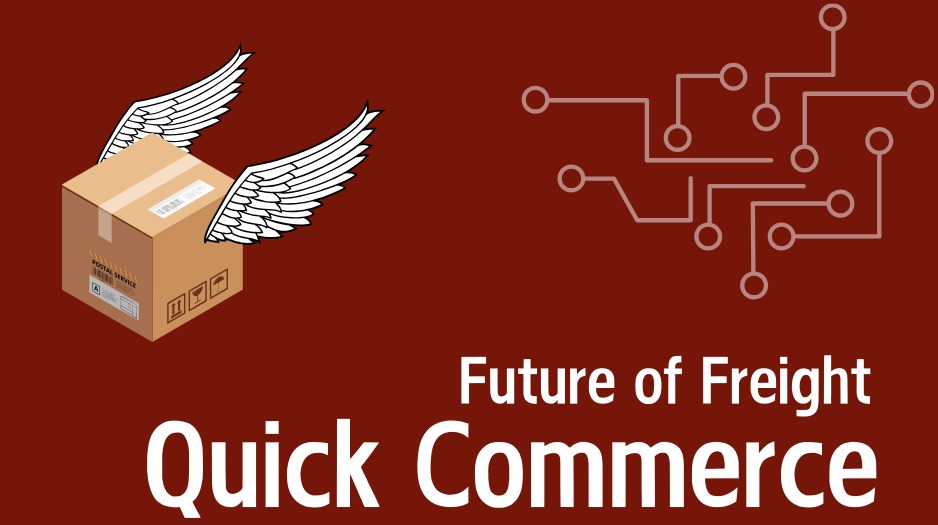
 Quick Commerce: Shaping the Future of Freight
Quick Commerce: Shaping the Future of Freight
Quick Commerce stands for convenient online ordering and fast delivery within one hour after receipt of the order. More and more industries are evaluating whether and how quick commerce can help them meet rising customer expectations. Read on to find out who is benefiting from quick commerce and what the logistical challenges are.
INFOBOX: The Essentials in Brief
It is not quick commerce vs e-commerce; rather, quick commerce is the turbo of e-commerce. E-commerce has accelerated traditional mail order into the 21st century, and quick commerce is taking it even further.
What is quick commerce all about?
- Fast delivery (ideally in less than an hour)
- Delivery from decentralized micro-fulfillment centers (so-called dark stores)
- Limited range of products (focus on fast-moving consumer goods)
- Delivery vehicles adapted for urban areas (e.g., two-wheelers, small transporters, mini delivery vans)
Significance of Quick Commerce in Logistics
- Quick commerce applies to the B2C sector, particularly to the last link in the logistics value chain: the last mile.
- Quick commerce requires the development of dark store networks tailored to the needs of the respective sector.
The vehicle fleet must also be adjusted to meet the requirements of fast delivery in urban areas. Last but not least, the individual process steps must be precisely interlinked to enable fast delivery. High quality process management is an essential prerequisite for quick commerce.
Quick Commerce:Examples from the Present, Prospects for the Future
As a complement to brick and mortar retail in urban areas, the introduction of Quick Commerce dates back to before the COVID-19 pandemic. At that time, retailers aimed to extend their core business with fast door to door delivery of everyday items such as groceries or drugstore products. However, the subsequent rise of quick commerce is closely linked to the pandemic.
COVID-19 Pandemic as Catalyst for Quick Commerce
Quick commerce took off only with the lockdowns, which led to an explosion of online orders. Since then, the market for quick commerce solutions in urban areas has grown rapidly. This trend is likely to continue on a global scale. Quick commerce for grocery delivery is now available in most urban areas around the world, partly through established retailers and partly through specialized quick commerce providers.
Not Every Industry Is Suitable for Quick Commerce
Quick commerce is not applicable to every business model or product segment. For example, it largely excludes the B2B sector and rural areas, where the quick commerce concept is not profitable. The low population density and corresponding low demand, on the one hand, and the necessary dark store infrastructure, on the other, are not economically viable.
Additionally, the weight and size of products are limiting factors for quick commerce. Large products such as furniture or flat-screen displays require more storage space than is available in typical dark stores, and transport involves larger vehicles. There is also the question of whether the cost of permanent storage for products that are not in constant high demand is proportionate to sales.
For this reason, sectors that are primarily concerned with rapid availability could benefit from quick commerce in the future. Besides the grocery and drugstore sectors, this could also apply to the supply of pharmaceuticals.
Chances and Challenges of Quick Commerce
In the age of e-commerce, customer loyalty can be driven not only by high quality products but also by a positive delivery experience. A hassle free online shopping experience, with delivery within one hour from order to delivery, helps companies attract and retain new customers.
However, the transition to quick commerce comes with risks that should not be underestimated. The changeover is costly in terms of fleet, personnel, and infrastructure. Furthermore, the required goods must be constantly available in the right quantities. Finally, delivery standards must be maintained at all times. If a company promises to meet customer expectations for smooth delivery in the shortest possible time but fails even once, it can lose relevance and face competitive disadvantages.
Quick Commerce in Summary
Quick commerce can be described as next generation e-commerce with exceptionally fast product delivery. As with e-commerce, the purchase process is entirely online. Products are delivered within one or a few hours after the order is placed. This is only possible over short delivery distances and is usually economically viable only in urban areas. Quick commerce requires a network of decentralized warehouses stocking a limited range of fast moving consumer goods.
